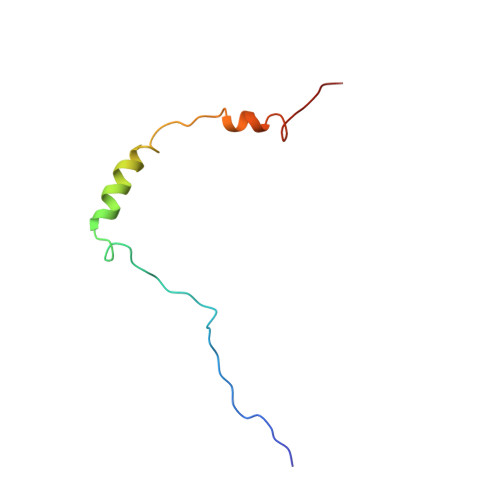Structural basis for sigma factor mimicry in the general stress response of Alphaproteobacteria.
Campagne, S., Damberger, F.F., Kaczmarczyk, A., Francez-Charlot, A., Allain, F.H., Vorholt, J.A.(2012) Proc Natl Acad Sci U S A 109: E1405-E1414
- PubMed: 22550171
- DOI: https://doi.org/10.1073/pnas.1117003109
- Primary Citation of Related Structures:
2LFW - PubMed Abstract:
Reprogramming gene expression is an essential component of adaptation to changing environmental conditions. In bacteria, a widespread mechanism involves alternative sigma factors that redirect transcription toward specific regulons. The activity of sigma factors is often regulated through sequestration by cognate anti-sigma factors; however, for most systems, it is not known how the activity of the anti-sigma factor is controlled to release the sigma factor. Recently, the general stress response sigma factor in Alphaproteobacteria, σ(EcfG), was identified. σ(EcfG) is inactivated by the anti-sigma factor NepR, which is itself regulated by the response regulator PhyR. This key regulator sequesters NepR upon phosphorylation of its PhyR receiver domain via its σ(EcfG) sigma factor-like output domain (PhyR(SL)). To understand the molecular basis of the PhyR-mediated partner-switching mechanism, we solved the structure of the PhyR(SL)-NepR complex using NMR. The complex reveals an unprecedented anti-sigma factor binding mode: upon PhyR(SL) binding, NepR forms two helices that extend over the surface of the PhyR(SL) subdomains. Homology modeling and comparative analysis of NepR, PhyR(SL), and σ(EcfG) mutants indicate that NepR contacts both proteins with the same determinants, showing sigma factor mimicry at the atomic level. A lower density of hydrophobic interactions, together with the absence of specific polar contacts in the σ(EcfG)-NepR complex model, is consistent with the higher affinity of NepR for PhyR compared with σ(EcfG). Finally, by reconstituting the partner switch in vitro, we demonstrate that the difference in affinity of NepR for its partners is sufficient for the switch to occur.
Organizational Affiliation:
Institute of Microbiology, Eidgenössiche Technische Hochschule Zurich, 8093 Zurich, Switzerland.















